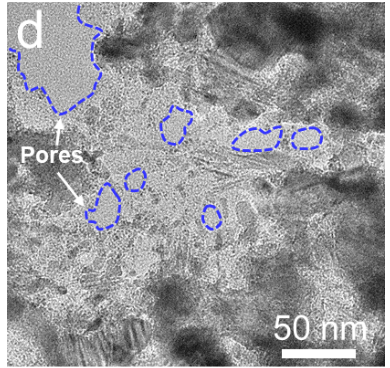
Development of Regular Macroporous Structure for Highly Efficient Hydrogen Evolution Reaction
Description: There is an urgent need to promote the reaction dynamics, gas release efficiency and mass transport of alkaline hydrogen evolution reactions, but it is very difficult to combine electrical and morphological engineering with the above mentioned points. On this basis, our group has successfully constructed a hierarchical, multiheterogeneous, three-dimensionally regular, macroporous, carbon-nitrogen-embedded ruthenium nanocluster RMS Mo2C/NC-Ru, which forms a Ru-NC heterostructure with optimal adsorption energy and adjustable electronic state for the intermediate H+. In addition, theoretical calculations confirm that the Mo2C-NC heterostructure accelerates the Volmer reaction due to its strong hydrolysis ability. The hierarchically regular macropore structure also allows the catalyst to have stronger mass transfer and gas release efficiency. Its mass activity is more than 17 times that of Pt/C. Therefore, RMS Mo2C/NC-Ru has the development prospect to replace Pt/C.
Today, the search for a new energy source to replace fossil fuels has become a hot topic in the scientific community. Among them, hydrogen is one of the most promising alternative energy sources due to its high energy density, sustainability and cleanliness. To meet the demand for hydrogen as an energy source, hydrogen is now commonly produced on a large scale using electrolytic water. Compared to acidic hydrolysis, alkaline hydrolysis in cation exchange membrane water electrolyzers (AEMWEs) not only reduces electrolyte damage to the electrodes, but also increases the availability of electrocatalysts. Although the electrocatalyst platinum-based material used in this application has high electrocatalytic activity, its price limits its wide application. Therefore, it is indispensable to design a catalyst for hydrogen precipitation reactions in alkaline environments with the electrocatalytic activity of platinum-based materials and without platinum-based materials. Ruthenium (Ru) is the less expensive precious metal of the platinum group, but at one-third the price of platinum, and has a similar bond strength to hydrogen as platinum. Its good chemical inertness to corrosive electrolytes makes it an excellent alternative to platinum. However, due to the high binding energy of active ruthenium nanoparticles (NPs), they tend to agglomerate, leading to a decrease in activity. To solve this problem, we have chosen to use a variety of carbon precursors to anchor the active ruthenium nanoparticles. The carbon carriers not only have good electrical conductivity, high stability, and rich functional groups, but also form heterogeneous structures with the ruthenium nanoparticles, while the strong interaction of the metal carriers adjusts the local electronic structure of the active sites and the free energy of hydrogen adsorption, further improving the electrocatalytic activity and stability. In addition, although the porous structure is favorable for reactant transfer, the air bubbles are easily blocked in the pores when passing through the disregular porous structure, which is not only unfavorable for rapid release, but the large number of air bubbles in the pores may hinder the approach of reactants and shield the catalytic active site, resulting in limited hydrogen production rate. In contrast, the three-dimensionally regular hierarchical macropore structure not only ensures the rapid transfer of reactants, but also improves the rate of gas release. In summary, a carbon-based complex carrier with a three-dimensionally regular hierarchical macroporous structure can be properly coupled with ruthenium nanoparticle particles to achieve better hydrogen precipitation in alkaline environments. To this end, we designed a three-dimensionally regular macroporous structure of Mo2C embedded with nitrogen reference nitrogen (RMS Mo2C/NC) as a carbon-based composite carrier coupled with ruthenium nanoparticles to obtain a layered and multiheterogeneous RMS Mo2C/NC-Ru composite.
Organisation: Pui Ching Middle School, Macau
Innovator(s): HU Ka Wai, PUN Chi Kin, LEONG Pok Hei, LAI Ian Man Catarina, WONG Ho Wa
Category: Energy
Country: Macau SAR

